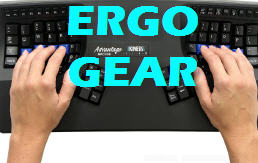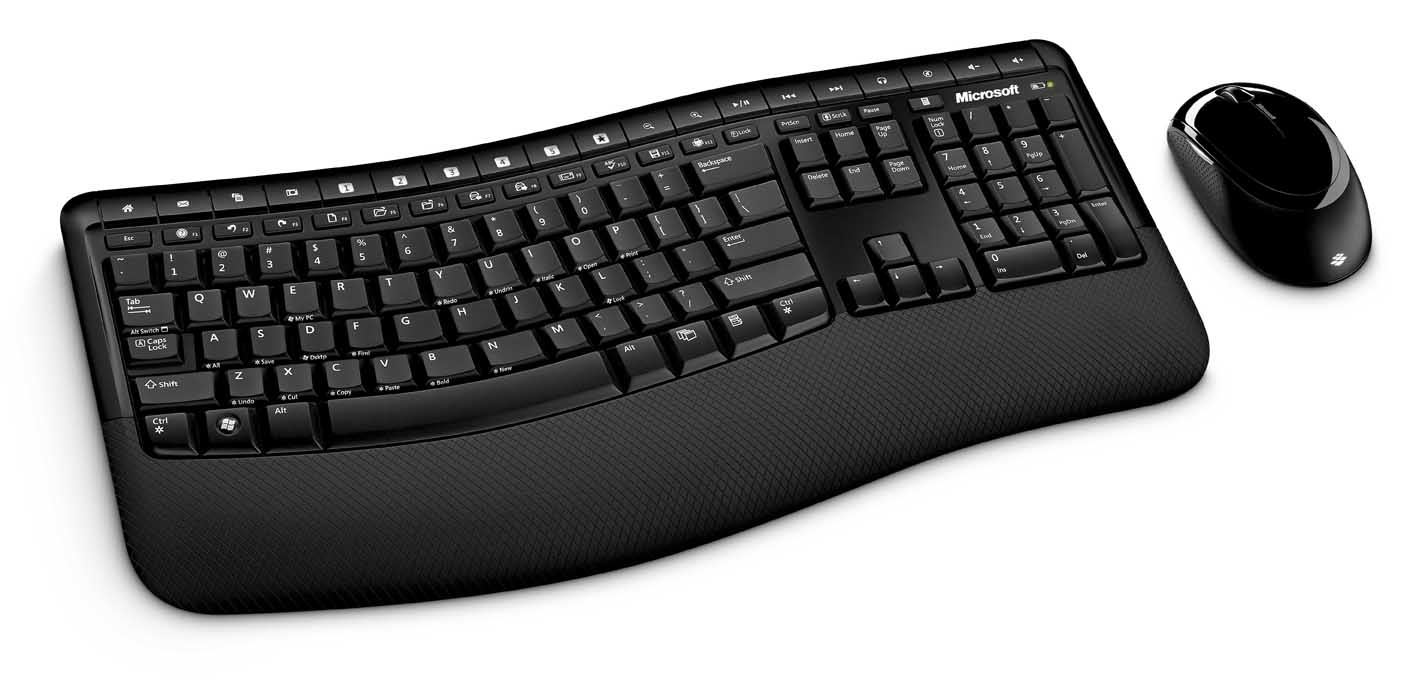Ergonomic Gear For A Better Life
Part 2: Keyboards, mice, and everything nice in between to help save your body from the pain associated with bad postures and designs.

Microsoft Wireless Comfort Keyboard 5000
Our article from earlier this week about the causes of technology-related pain should've convinced most of us that no solution is a perfect one for our bodies. We thus have to find the best compromises among different solutions. On that note, let’s turn to products from the ergonomic keyboard leader, Microsoft.
Ever since high school, I’ve been a 35 word-per-minute, hunt-and-peck typist. This regrettable fact led me to enlist the help of several other people, all of whom are faster touch typists, in assessing the following keyboard products.
Microsoft sent two keyboard/mouse combinations for review: the forthcoming Wireless Comfort Desktop 5000 ($80) and the Natural Ergonomic Desktop 7000 ($120). The 5000 keyboard uses (to borrow Logitech’s term) a “wave” keybed design, with the main keyboard arranged along a gentle, smile-like curve. Officially, Microsoft calls this the Comfort Curve. Because of the curve, the keys near the center of the bed (G, H, B, and N most of all) are longer than keys near the left and right edges. In effect, the purpose of the design is to prevent ulnar deviation, just as a split design does, only the wave avoids having a split. Again, this is a compromise. A true split allows for even less ulnar deviation, but when it comes to ergonomics, every degree counts, while “hunt” typists like me can adapt to a wave design much more easily than a true split.

I’m not terribly interested in all of the 5000's macro and function keys, although the low-battery indicator is cool. I’m more interested in the unit’s rubber, textured wrist rest. I generally prefer soft wrist rests, and the 5000's is very firm, almost as hard as plastic. But the texture helps to keep your hands from sliding across the rest surface, so you stay centered and don’t have to expend shoulder or upper arm effort in repositioning all the time. I also found the steep taper of the rest to be more comfortable than I expected.
The 5000 also integrates a great feature for preventing wrist extension. You’re familiar with how nearly all keyboards feature feet near the top of the underside. If you flip the feet down, the top of the keyboard stands taller than the bottom. But not every user/desk configuration benefits from this orientation. Microsoft designed the rubberized feet in the 5000 to twist and snap out, then snap back into matching holes near the bottom of the underside, thus elevating the area under your palms. If you have a relatively low desk or a high chair, or (as my mother-in-law does), if you’re particularly susceptible to pain from wrist extension, then this bottom elevation can help keep you neutral and reduce strain.
Overall, there’s some ergonomic benefit to the 5000 keyboard. You may have to endure an adjustment period to train your fingers on the variable-sized keys, but the advantages over a standard straight keyboard will be worth a few hours of conditioning.
Sign up to get the BEST of Tom's Guide direct to your inbox.
Get instant access to breaking news, the hottest reviews, great deals and helpful tips.
Current page: Ergonomic Gear For A Better Life
Next Page Microsoft Natural Ergonomic Keyboard 4000William Van Winkle is a freelance editor and tech journalist who has been writing for more than 20 years. His work has appeared on Tom's Guide, Tom's Hardware, Tom's IT Pro, AMD, Seagate, Computer Shopper, and more. He is also an author, writing poetry, short stories, and science fiction and fantasy books.
-
Luscious I'm quite surprised your focus is on ergonomics yet you haven't mentioned anything at all about trackballs. I've been using a Logitech Track Man Wheel for close to 4 years paired with my notebook. They have many advantages over mice, not the least being ergonomically superior.Reply -
Supertrek32 I've been using the Microsoft Natural Ergonomic Keyboard 4000 for a few years now and must say that I love it. Very comfortable. I also reprogrammed the back/forward buttons to control media player (via Microsoft's intellitype software), which is incredibly hand for someone like me who has a large music collection and might not be in the mood for a certain genre one day.Reply -
IzzyCraft ryanegeigerI agree... what about trackballs?trackballs are perfect for work only situations esp with limited desk space.Reply -
ddrcoder I've used a Kinesis for years (I'm typing this with one right now), and I must say they're the best keyboards ever made. I've found that they relieved stress in my hands/wrists. I recommended them to a friend who couldn't touch type and as he got used to the keyboard, he quickly learned. He can now type at 60WPM, I can type at 100WPM.Reply
-Tom -
Trackballs, why have they been blackballed? Everyone I loan my spare, I have three new ones just in case they stop selling them, Logitech mouse man marble to they immediately buy one for themselves.Reply
My friend has CTS and cannot use a regular mouse with one hand because of the strain, trackball fixed him right up. Not only are they friendlier on the wrist the require vastly less desk space, they are easier to control and for precision work nothing beats a trackball.
My Gaming (counterstrike: source, UT2004, UT3, half life, team fortress, day of defeat,etc) buddies all have crazy expensive uber dpi programmable gaming mice that have lasers, and my 20$ trackball whips 'em every time. Why? no wasted movement, my arm is completely stationary when mousing, my fingers can keep the ball fluid and moving in one direction without having to lift it up, move it ove,r set it down, and continue mousing, one quick flick of the finger and the ball goes spinning in the desired direction, all while my arm is relaxed and stationary.
They are in fact perfect in play situations too.
How about some trackball love? -
coconutboy I like these kinds of articles. Currently I own a logitech MX Revolution, it's my ~5th logi mouse (I also own a cordless logitech trackball), but really all these have just been because I couldn't find anything better including the gazillion specialized ergo mice on the market. I just wish someone would make an upright/joystick-like mouse that also includes-Reply
a trackball
scroll wheel or similar device
4 buttons minimum (5+ preferred) that users can define as forward/back/whatever.
I've tried many mice including the 3M joystick, Zero Tension Mouse and Evoluent upright. Those were somewhat better in terms of comfort but sacrificed buttons/functionality. As a result my last 4 or so mice have all been Logitech with my current being the MX Revolution but that's because of the extra buttons and its awesome scroll wheel, NOT the comfort which is just average.
William Van WinkleI was able to try out Logitech’s MK605 notebook kit ($100)... The keyboard and mouse are okay, and they are decently compact for travel, but I wish the stand were available separately.
The stand can be purchased individually for $30. Linkage-
http://www.logitech.com/index.cfm/notebook_products/stands/devices/5494&cl=us,en
-
williamvw The stand can be purchased individually for $30. Linkage-http://www.logitech.com/index.cfm/ 4&cl=us,enReply
Oh, bonus! Thanks for pointing that out, coconutboy. Again -- highly recommended. -
tapeglue Less known help for wrist pain can be a computer armrest. I have been using one called Restman 1 for a few months now and it indeed makes me forget about my wrist problem. I got it from http://restmans.myshopify.com/products/restman-1.Reply -
trifler I find that mice with higher dpi allow me to turn up the speed without losing any of the control. This greatly reduces the amount of necessary wrist movement to use a mouse. Therefore, I actually choose the Logitech G500 (5700dpi) for ergonomic reasons rather than for gaming reasons.Reply
